List 4 capabilities of the discrete event simulation softwar
Solution
ABSTRACT
Simulation has become a more valuable tool for many corporate sectors. Simulation is not only used for planning but also in designing phase. Simulation provides various advantages and most importantly we can analyze system before actually establishing it. Different simulation software are available in the market and these software are established on different approaches, which ultimately changes features of simulation. Different approaches have their own advantages and disadvantages. The simulation branch is presented by three approaches; they are, simulation on microscopic level, simulation on mesoscopic level and simulation on macroscopic level. Manufacturing process is one of the area, where simulation found to be more useful tool in design and operational decision making. Also scheduling of the flexible manufacturing system can be done effectively by using simulation. The success of simulation is based on the model design. If model is developed correctly, simulation will provide accurate results. So model development becomes a important factor in simulation. These models are subjected to changes and corresponding runs to determine the system behavior. This paper presents various simulation approaches, modeling in simulation and various advantages and limitations of the simulation software.
Keywords: Simulation Approaches, Modeling, Manufacturing Process.
ABSTRACT
Simulation has become a more valuable tool for many corporate sectors. Simulation is not only used for planning but also in designing phase. Simulation provides various advantages and most importantly we can analyze system before actually establishing it. Different simulation software are available in the market and these software are established on different approaches, which ultimately changes features of simulation. Different approaches have their own advantages and disadvantages. The simulation branch is presented by three approaches; they are, simulation on microscopic level, simulation on mesoscopic level and simulation on macroscopic level. Manufacturing process is one of the area, where simulation found to be more useful tool in design and operational decision making. Also scheduling of the flexible manufacturing system can be done effectively by using simulation. The success of simulation is based on the model design. If model is developed correctly, simulation will provide accurate results. So model development becomes a important factor in simulation. These models are subjected to changes and corresponding runs to determine the system behavior. This paper presents various simulation approaches, modeling in simulation and various advantages and limitations of the simulation software.
Keywords: Simulation Approaches, Modeling, Manufacturing Process.
ABSTRACT
Simulation has become a more valuable tool for many corporate sectors. Simulation is not only used for planning but also in designing phase. Simulation provides various advantages and most importantly we can analyze system before actually establishing it. Different simulation software are available in the market and these software are established on different approaches, which ultimately changes features of simulation. Different approaches have their own advantages and disadvantages. The simulation branch is presented by three approaches; they are, simulation on microscopic level, simulation on mesoscopic level and simulation on macroscopic level. Manufacturing process is one of the area, where simulation found to be more useful tool in design and operational decision making. Also scheduling of the flexible manufacturing system can be done effectively by using simulation. The success of simulation is based on the model design. If model is developed correctly, simulation will provide accurate results. So model development becomes a important factor in simulation. These models are subjected to changes and corresponding runs to determine the system behavior. This paper presents various simulation approaches, modeling in simulation and various advantages and limitations of the simulation software.
1. INTRODUCTION
Simulation has been used for the decades as a tool to support decision making in manufacturing systems. It is far cheaper and faster to build a virtual system and experiment with different scenarios and decisions before actually implementing the system [1]. Applying simulation begins by being clear on the problem definition, the reason for simulation and the expected outcomes [2]. Simulation means to mimic or imitate. It involves such activities as defining, designing, and constructing a model or representation; defining the experiments to be conducted; collecting and analyzing the data to drive the model; and analyzing and interpreting the results obtained from the experiments [3].
Recent advances in simulation software have allowed simulation to expand its usefulness beyond pure design function into operational use. The objective is to use simulation software for operational support used for scheduling, daily resources allocation, and process monitoring. In order to implement a tool a virtual model has been designed to conduct the experiment. Now days, simulation is a tool mainly used for different types of production system analysis [4, 5]. This paper discusses various simulation approaches, reasons for simulation use through its advantages, and some basics of modeling in simulation software.
2. SIMULATION APPROACHES
Simulation is the powerful tool for systems analysis and investigation. Simulation can be presented by three approaches; they are simulation on the microscopic level, simulation on the mesoscopic level and simulation on the macroscopic level. Figure 1 shows the various approaches. Microscopic approach is further categories into; Discrete-Event Simulation (DES) and Agent Based Simulation (ABS) where as Macroscopic approach is of System Dynamics (SD) type [4].
Figure 1. Simulation Approaches [4].
2.1 MICROSCOPIC SIMULATION
The simulation on the microscopic level is widely used for a moment. The main idea of the simulation on microscopic level could be described in the following way; objects and resources are highly detailed in their description. Thus, each experiment needs a number of runs and only after that data could be aggregated to get the final result. At present two methods of simulation on micro-level are well known. They are; discrete event simulation and agent based simulation [4].
2.1.1 Discrete Event Simulation (DES)
In DES, system components are modeled as “objects” with attributes. The sates of the object change in response to specific “events” that do not occur at evenly specified point of time, they can occur at random and several events can occur at the same time [1]. DES allows us to dynamically analyze different samples of parameter value in software process instances. Using DES, process experts often find it easy to observe or discover process bottlenecks and optimization alternatives. Similarly when repetitive, high frequency process are being studied, then DES provides a basis for assessing and validating replicablity of the simulated process to actual experience [5]. One of the disadvantages of this type of simulation is that it requires more runs. Current commercial DES software includes ARENA, AutoMod, Witness, Flexsim, SLX, Extend, and ProModel [1]. Figure 2 presents simple production line modeled using the DES software FlexSim.
Figure 2. A typical production line in DES software [1].
2.1.2 Agent Based Simulation (ABS)
In Agent Based Simulation, the system components are model as “agents” as opposed to “objects”. Agents and interaction between agents are described in simple rules while pattern, structures, behaviors, and complex dynamics emerge from the interactions. Because ABS is a new modeling and simulation tool, there is no universal agreement on the definition of “agents” [1]. It can be defined as essentially-decentralized a individually- centric approach to the model design [4]. When and designing and agent base model the modeler identifiers the active entities, the agents (That can be people, companies, projects, assets, vehicles. Cities, animal, etc.), define their behaviors puts them in a certain environment, perhaps, establishes connections and runs the simulation [4]. Figure 3 shows the basic simulation model in ABS.
Figure 3. Agent based simulation model [1].
2.2 MACROSCOPIC SIMULATION
Macroscopic simulation is presented only with one paradigm. This paradigm is system dynamics (SD). This approach was developed by Jay Forrester in 1950’s. In fact the system dynamics is a set of differential equation. That is why the system dynamic does not deal with particular object, but with aggregate set of object which flow from one stock to another with strength which is defined with the flow variables [4].
2.2.1 System Dynamics (SD) Simulation
SD models are continuous models governed by differential or difference equation to simulate interaction between different components of the system. The principles of system dynamics were developed by forrester under the name of industrial dynamics. Wolstenholmes define system dynamics as “rigorous method for qualitative description, exploration and analysis of complex systems in terms of their processes, information, organization structures and strategies which facilitates simulation modeling and quantitative analysis for the design of the system structure and control”[1].
In the field of manufacturing systems modeling, SD has been used in many applications. Current commercial system dynamic simulation software includes Vensim, Stella, iThink, Powersim, and simile [1].
2.3 MESOSCOPIC SIMULATION
It is something the middle of microscopic and macroscopic approach. This system uses advantages from both of them. This approach is really universal and could be applied to any application area. The mesoscopic approach is innovative and its conception is still in progress of development [4].
3. MODELING IN SIMULATION SOFTWARE
Eliciting and capturing informal process descriptions, then converting them into formal process models or process model instances [5]. Basically, this model has been built to do the experiments in order to implement the objectives of the work [3]. The model is used to identify critical stations and find the optimal system through put using various scenarios. It helps to determine new maintenance scheduling schemes and evaluate their effects on the overall system performance. We establish system simulation model to do “what if” analysis [6].
The designing of model starts with assumption. For example if we consider automobile components manufacturing process, there will be assumptions like; three shifts per day, eight hours per day, resources and material flow for station is uninterrupted etc. The parameter of modeled process is subjected to the change with number of runs. Also successive runs will optimize the process [7]. Another importance of this modeling lies in the fact that it provides a quantitative evaluation for the maintenance operation from the production’s viewpoint. After modeling, multiple run has to be carried out with different system parameters of the model [6]. Then effect of change in parameters is studied.
Analysis: Evaluating the static and dynamic properties of a process model, including its consistency, completeness, internal correctness, traceability, as well as other semantic checks. Analysis also addresses the feasibility assessment and optimization of alternative process models [5].
Simulation: Symbolically enacting process models in order to determine the path and flow of intermediate state transition in ways that can be made persistent, replayed, queried, dynamically analyzed and reconfigured into multiple alternative scenarios [5].
Redesign: Reorganizing and transforming the structure of relationship within a process to compress completion time, as well as reduce or eliminate the number of steps, handoffs, or participants [5].
Visualization: Providing users with graphic views of process models and instances that can be viewed, navigationally traversed, interactively edited and animated to convey an intuitive understanding of process statics and dynamics [5].
4. ADVANTAGES AND LIMITATIONS OF PRESENT SIMULATION SOFTWARE
Day by day the use of simulation software increasing tremendously, because of its various advantages. At the same time there are few drawbacks which encounters in simulation software.
4.1 ADVANTAGES OF SIMULATION SOFTWARE
4.1.1 The Role of Simulation has Changed
Simulation started as a technology practiced by the experts who understood and could utilize the software applications. The technology that is used to be the realm of experts is starting to be recognized as a tool that’s available to much wider audience for analyzing and solving real word problems [2].
4.1.2 Simulation Software has Become Ease to Use
“Ease of Use” is a common and possibly over-used term to attempt to describe how easily simulation can be built. The feature provided in the software allows user to understand and use it smoothly [2].
4.1.3 Simulation Application have Broadened in Scope
Simulation isn’t just about manufacturing anymore. It has wide variety of domain in which simulation is applied. Its universality can be seen from its application areas, which includes from manufacturing to container terminals, from airport security to emergency response, from mining to health care, etc. [2].
4.1.4 3D Visualization
The 3D visualization is also one of the important feature of simulation software. It allows us to grasp the system with less efforts. There is another feature of simulation software that it allows direct import of 2D and 3D drawings which plays important role in improving the simulation and modeling features [7]. It is easy to make 3D animation and realize the system as whole.
4.2. Limitations of Simulation Software
There exists two fundamental limitations to the current simulation techniques. These limitations can be minimized in some extent by getting expertise in handling simulation software. Also correct simulation modeling is important in order to avoid its limitation in some extent.
4.2.1 Multiple Simulation Runs
The main use of the simulation is assisting in decision making design or operation of the system. Assisting comes in the form of allowing decision makers to experiment with different ‘what if” scenario and evaluate the outcomes of different decisions. This works well when the decision makers need to choose between a few possible changes, but when there are too many possible decisions as well as two many scenarios, it become a little hindering and exhaustive. For example, if the system consists of 10 components and each component has only 2 possible alternatives, then there are 210 = 1024 alternatives to be investigated. Conducting this number of simulation is tedious, time consuming, impractical and prone to error [1].
4.2.1 Changing System under simulation
Simulation tries to be real systems as accurate as possible. However, while real systems are dynamics and changing, simulation is rapid and static in both structure and parameters. This problem becomes more obvious when simulating a system over a long period of time. In such cases, in order to have an accurate simulation the system has to be dynamic and react to simulation outputs by introducing changes to the system under simulation [1].
5. CONCLUSION
There is no doubt about the importance of simulation in studying real-world operations. Simulation has now become a prime decision making tool for not only to manufacturing decision makers but also to the other corporate sectors. On process utilization of simulation software provides great advantages in controlling the process parameters. There is a need for a new simulation methodology that enables the required continues exploration and evaluation of relevant changes. Because the process of exploration and evaluation is continues, it should be executed autonomously based on a knowledge base built into simulator. Continues upgrading of simulation software will make it most demanding software. Also new simulation approaches will make it precise tool.
| ABSTRACT Simulation has become a more valuable tool for many corporate sectors. Simulation is not only used for planning but also in designing phase. Simulation provides various advantages and most importantly we can analyze system before actually establishing it. Different simulation software are available in the market and these software are established on different approaches, which ultimately changes features of simulation. Different approaches have their own advantages and disadvantages. The simulation branch is presented by three approaches; they are, simulation on microscopic level, simulation on mesoscopic level and simulation on macroscopic level. Manufacturing process is one of the area, where simulation found to be more useful tool in design and operational decision making. Also scheduling of the flexible manufacturing system can be done effectively by using simulation. The success of simulation is based on the model design. If model is developed correctly, simulation will provide accurate results. So model development becomes a important factor in simulation. These models are subjected to changes and corresponding runs to determine the system behavior. This paper presents various simulation approaches, modeling in simulation and various advantages and limitations of the simulation software.
Keywords: Simulation Approaches, Modeling, Manufacturing Process.
|
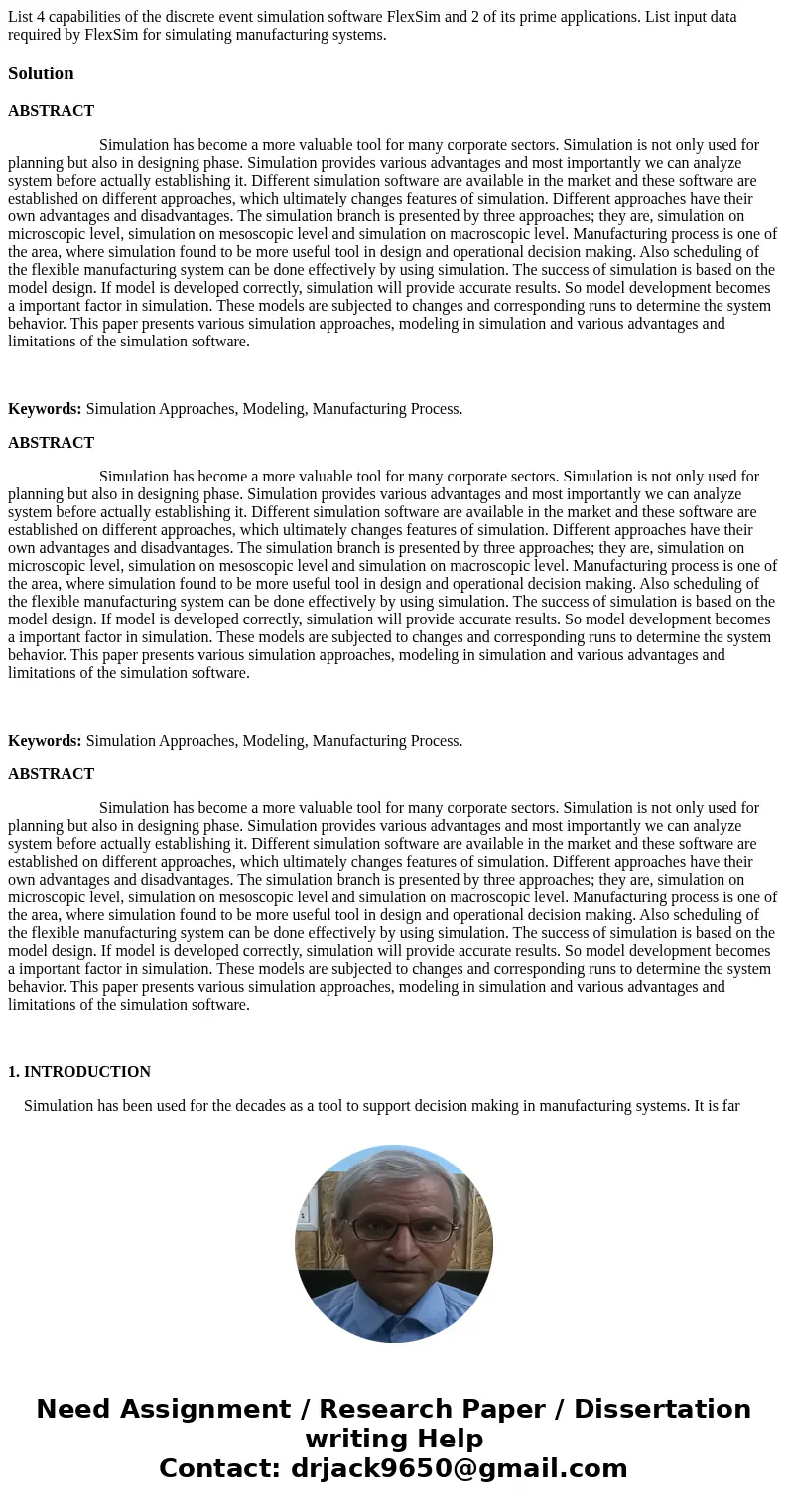
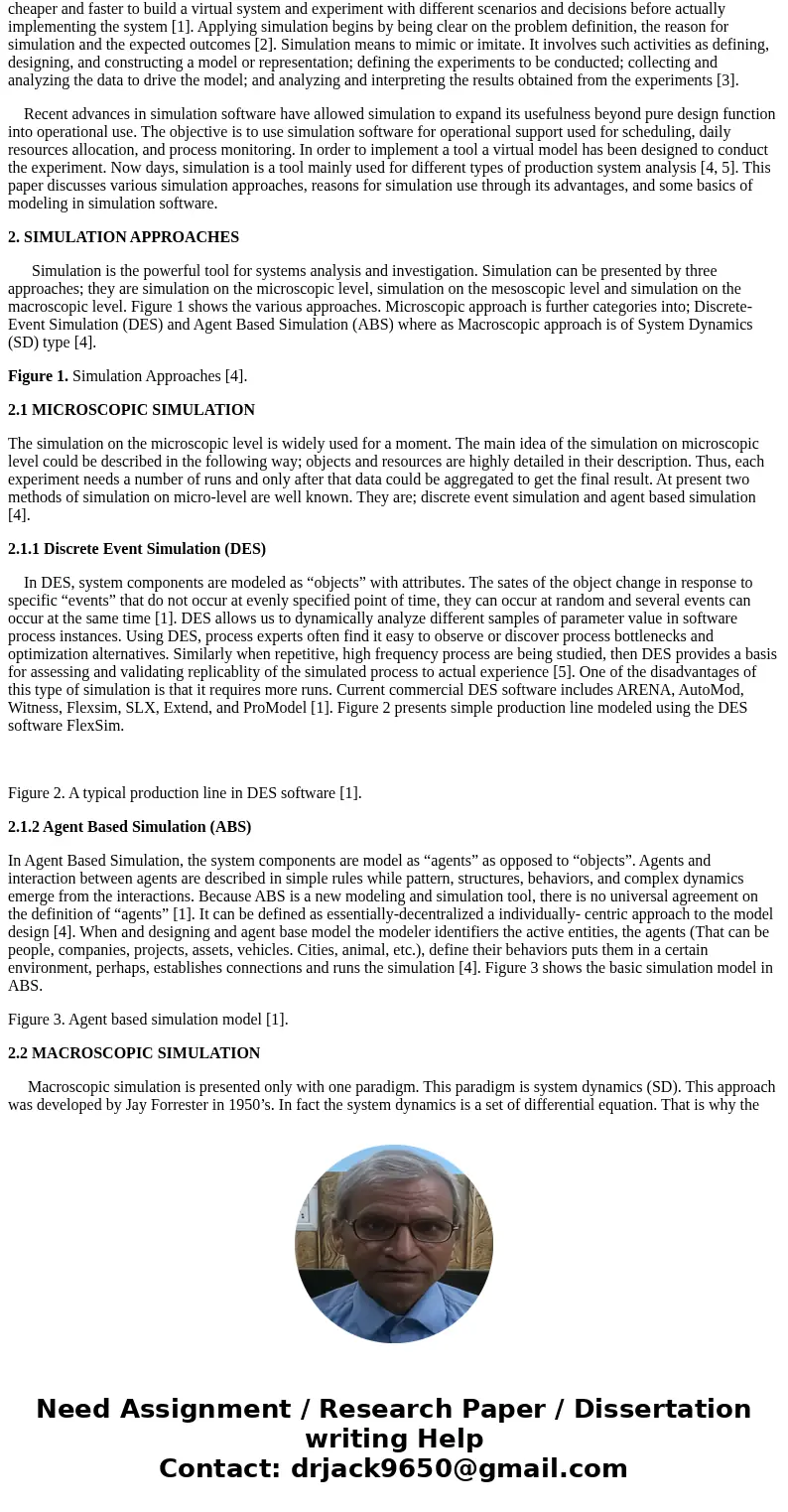
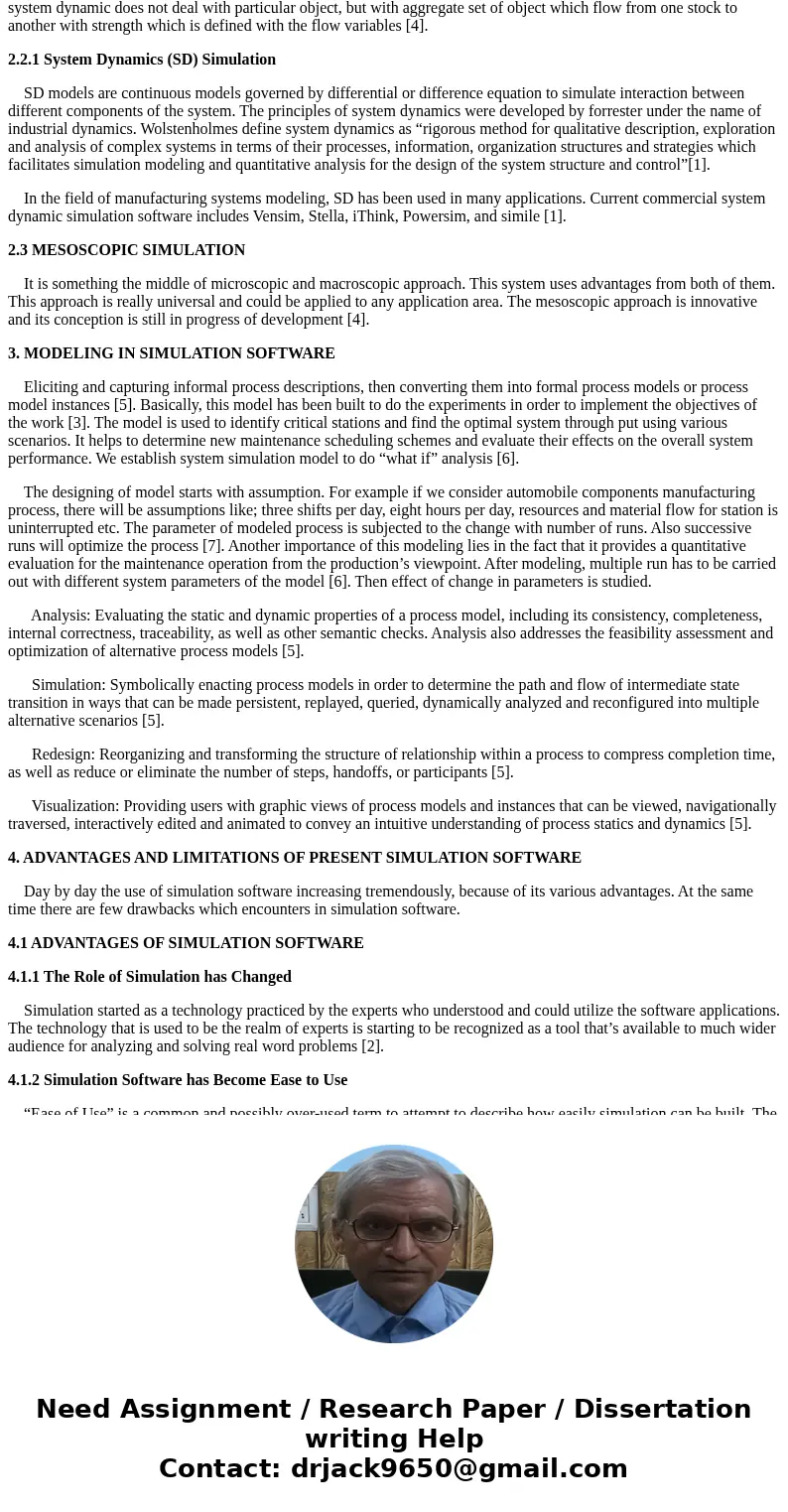
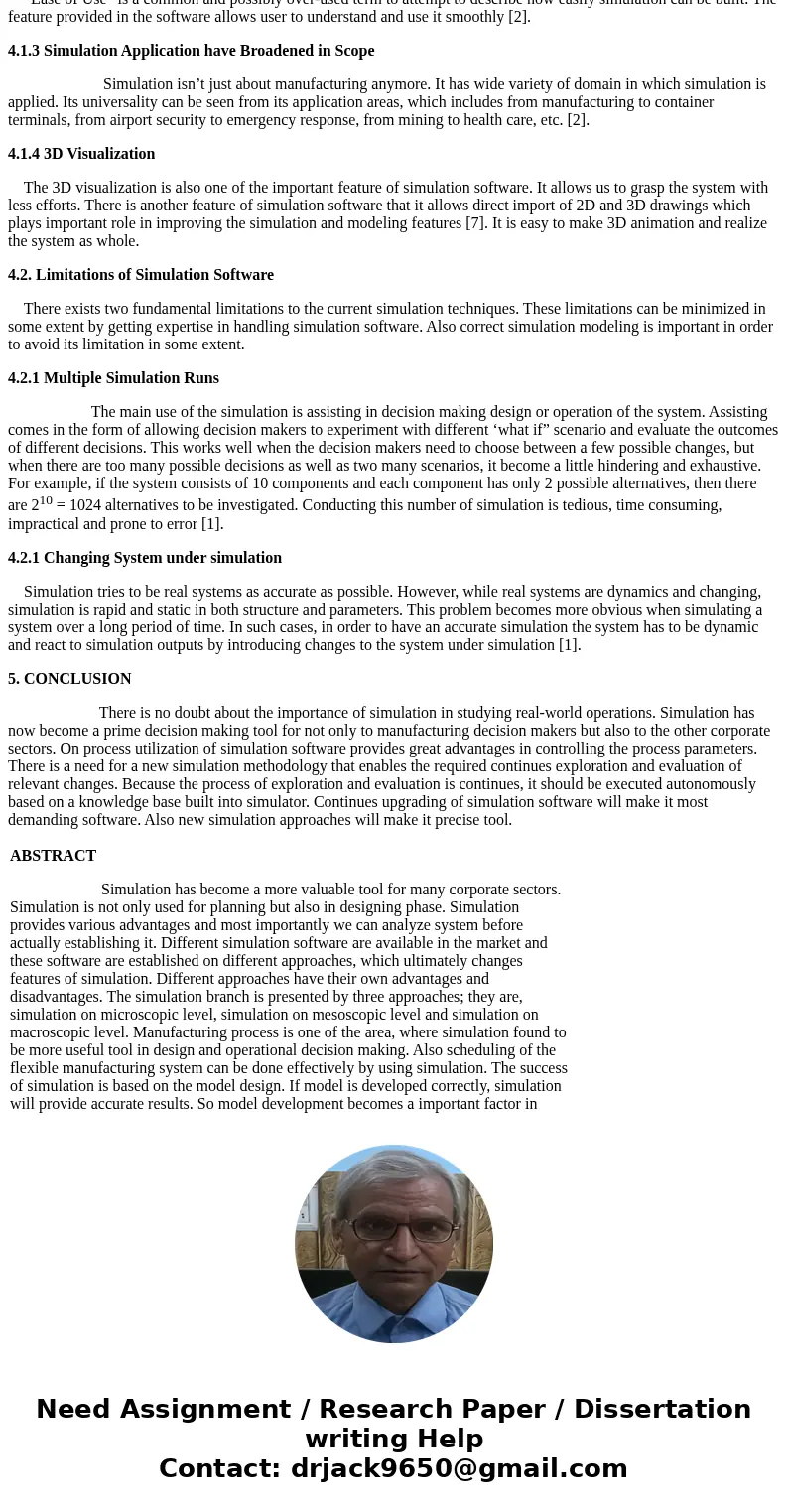
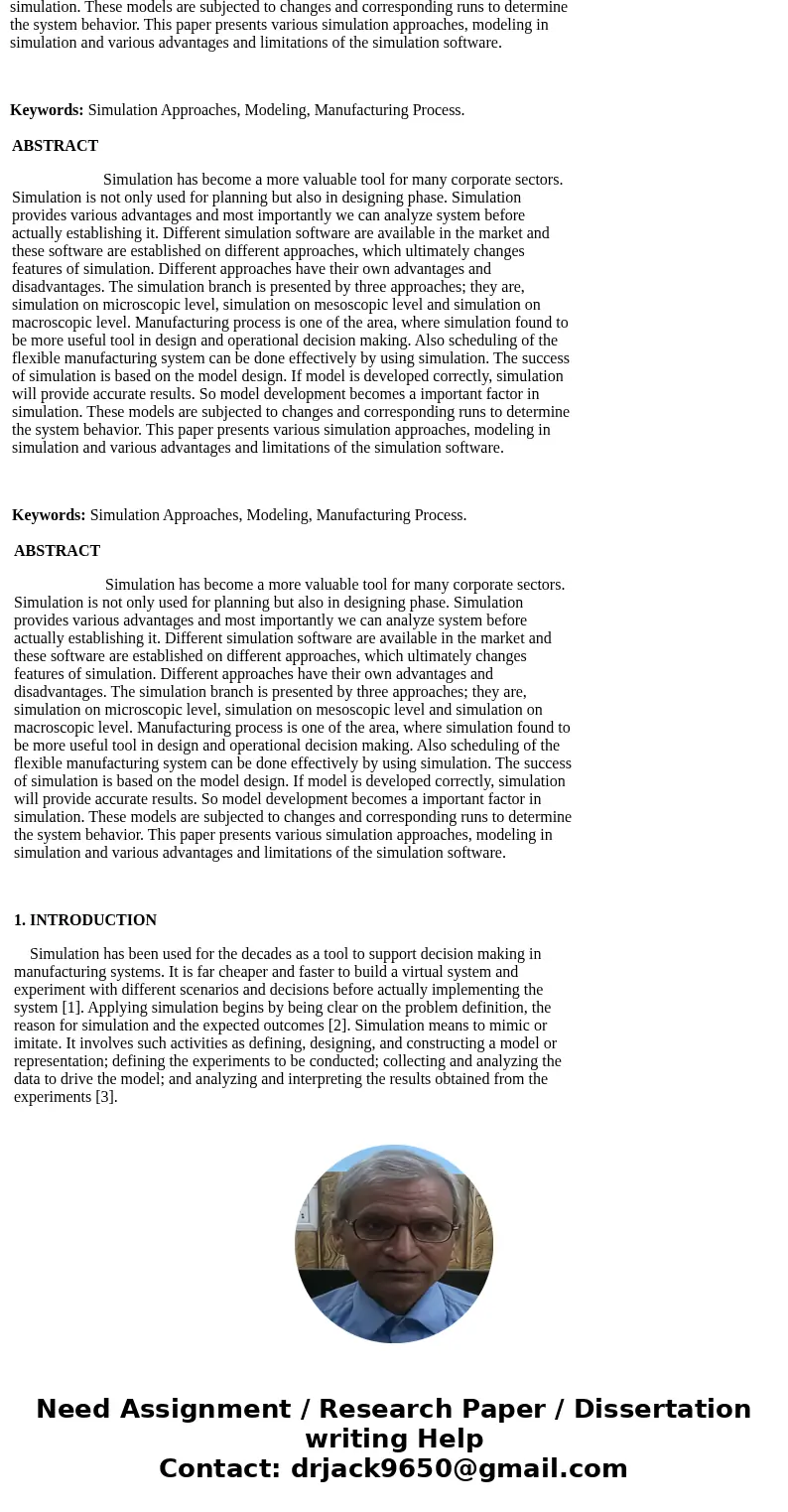
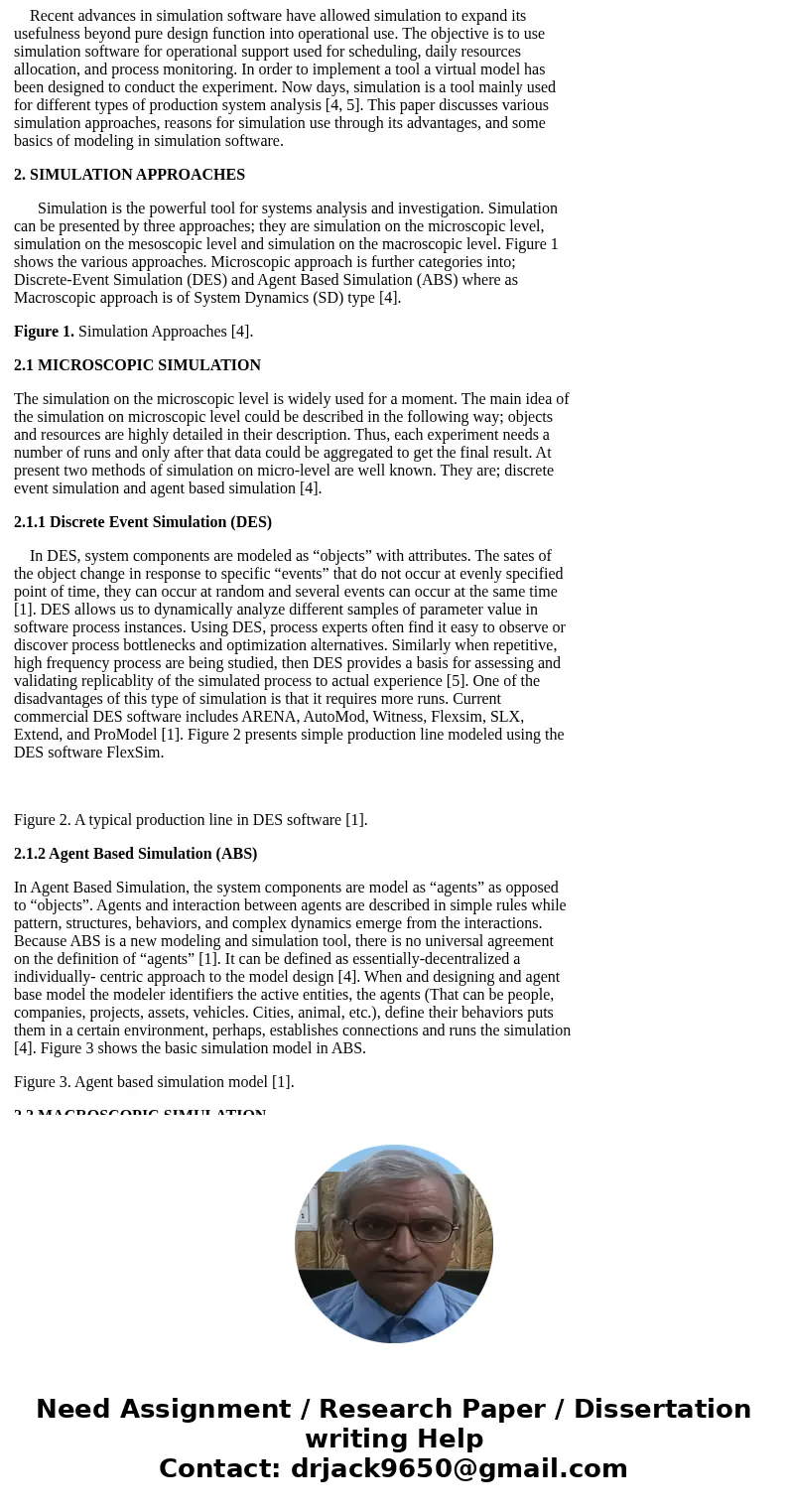
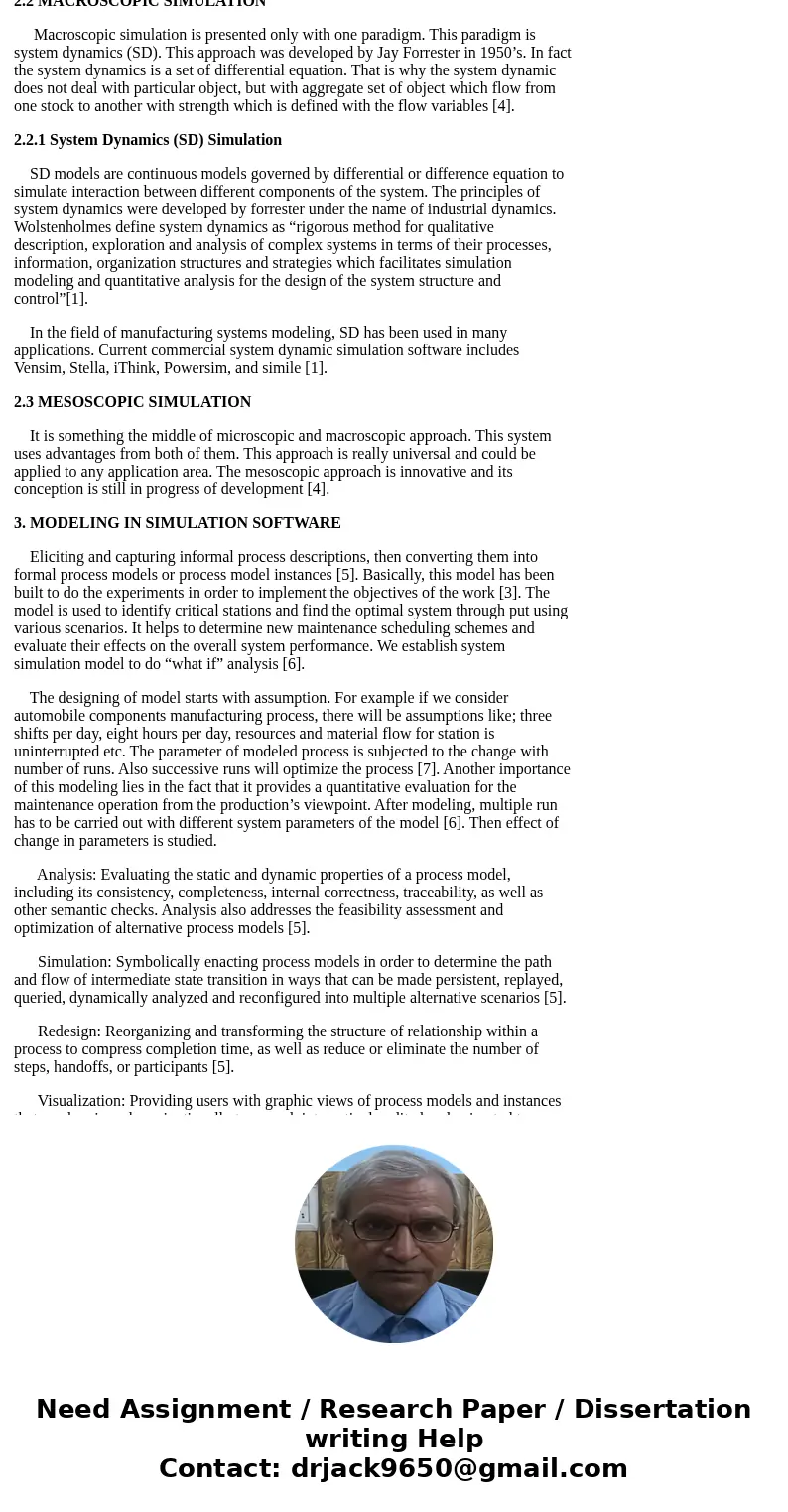
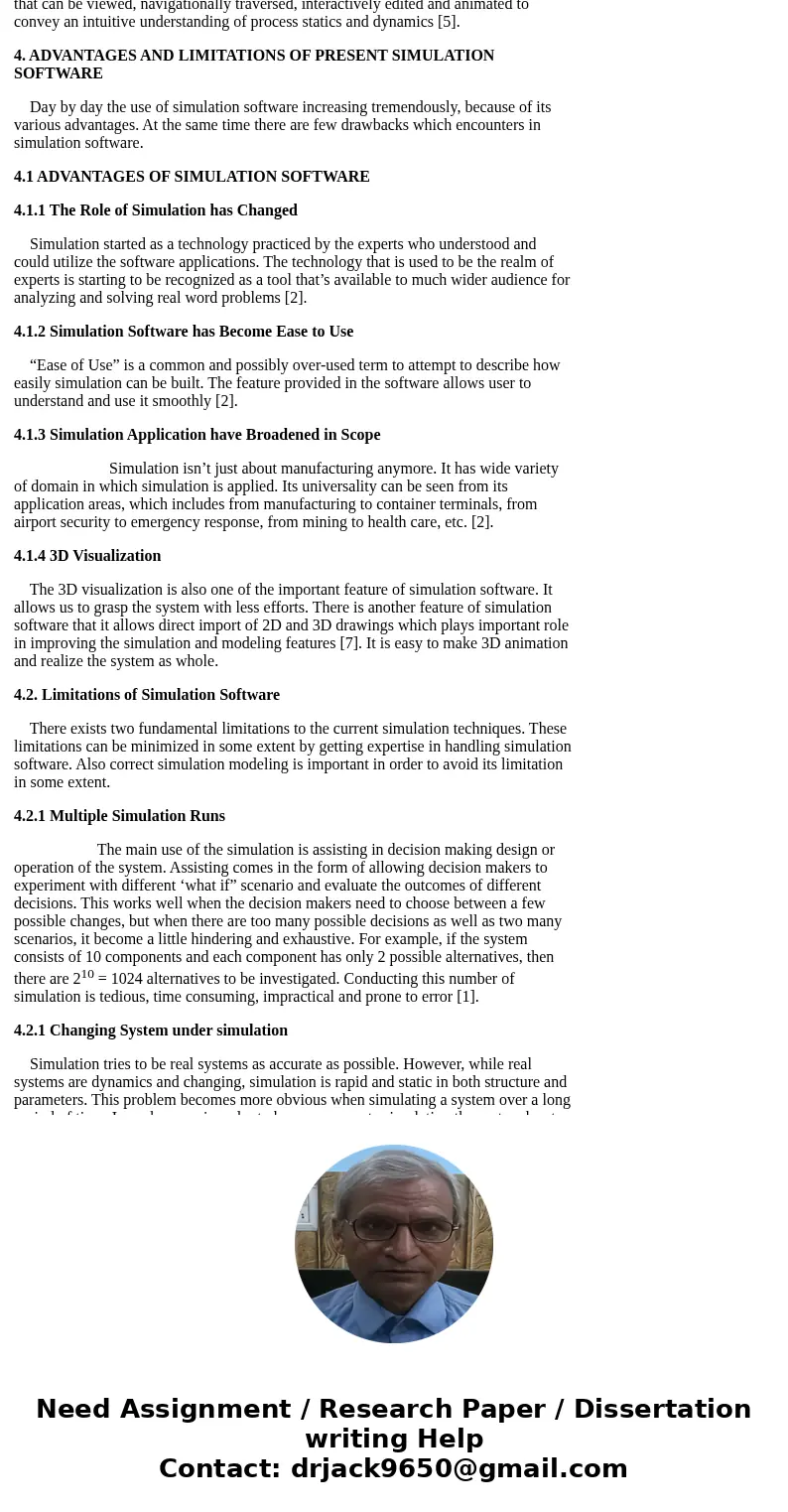
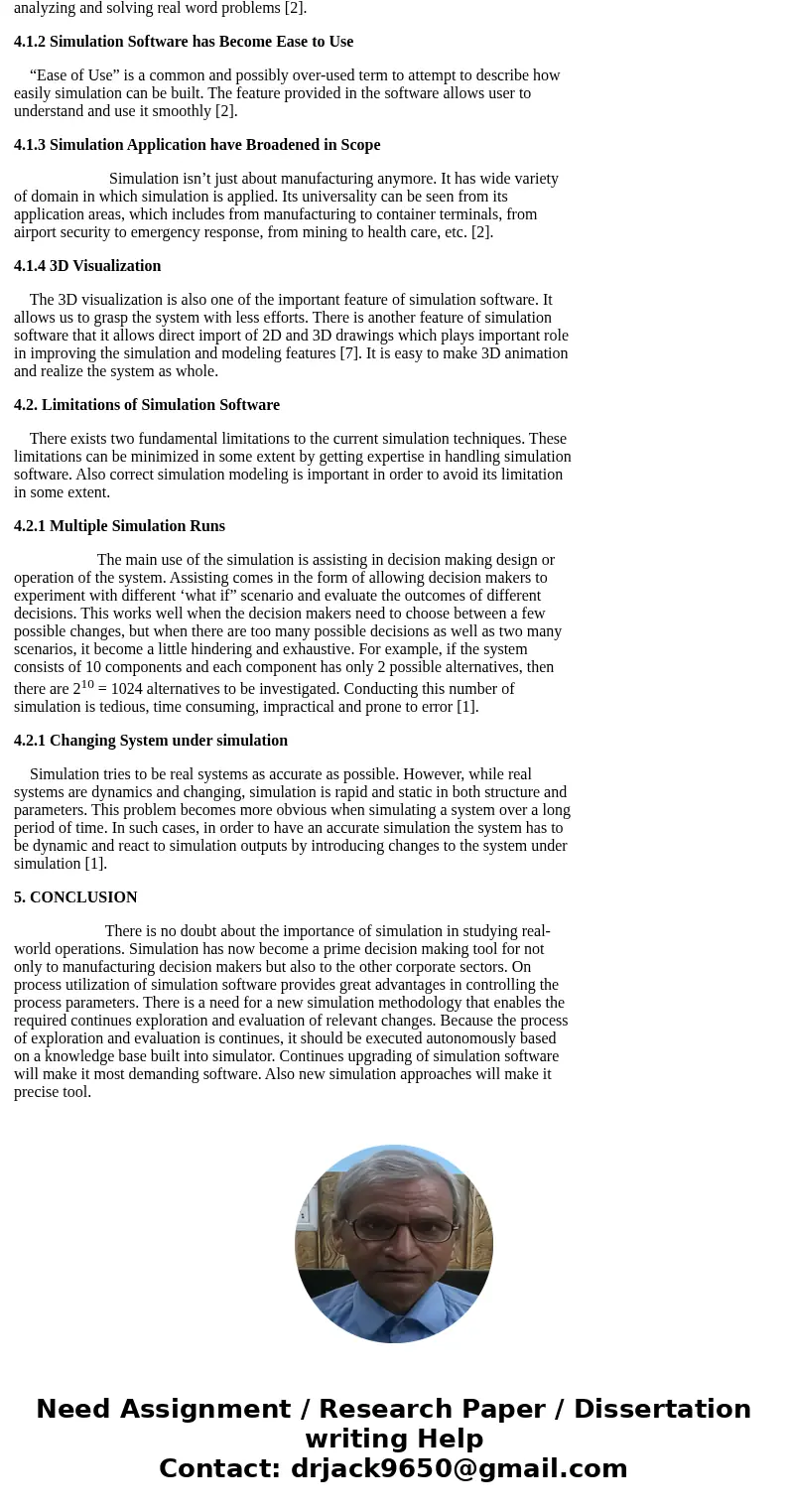
 Homework Sourse
Homework Sourse